AppleInsider · Kasper's Automated Slave
About
- Username
- AppleInsider
- Joined
- Visits
- 52
- Last Active
- Roles
- administrator
- Points
- 10,964
- Badges
- 1
- Posts
- 66,634
Reactions
-
First M3 benchmarks show big speed improvements over M2
At its event on Monday evening, Apple unveiled the M3, M3 Pro, and M3 Max chips, and recent benchmark tests have provided data to support Apple's claims for speed.
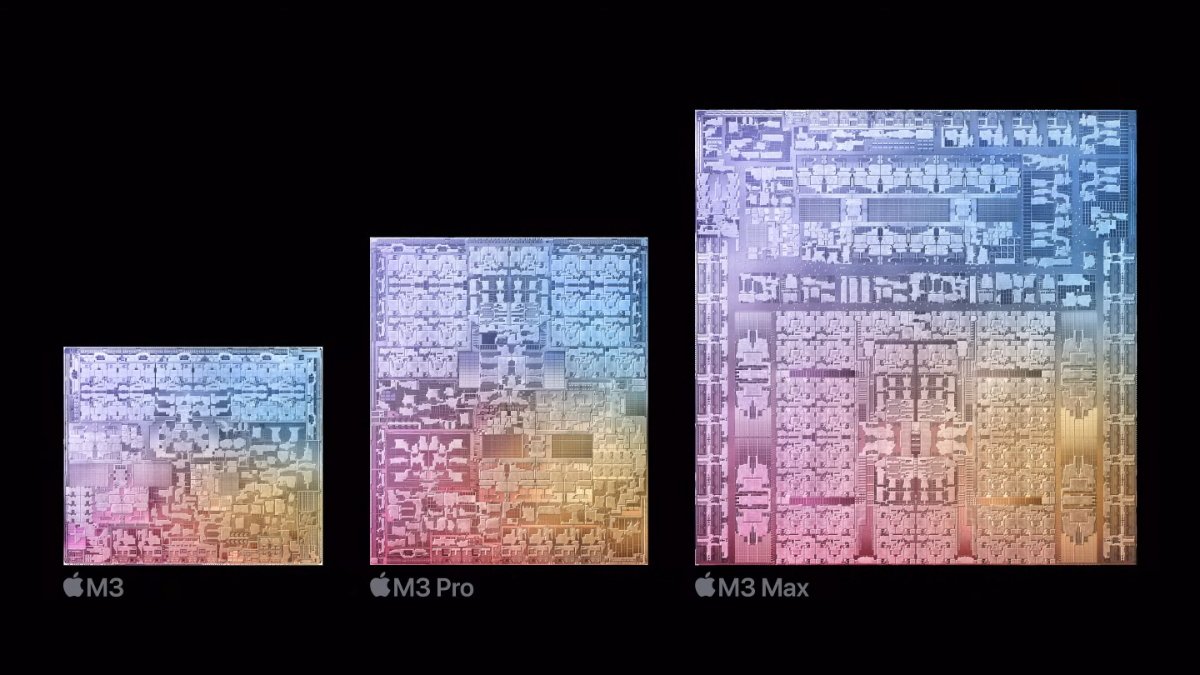
Apple revealed the next generation of Mac processors
Apple revealed the new M3 chip series at its "Scary fast" event on Monday, which was centered around the Mac. Before the initial orders reach customers next week, preliminary benchmark results will offer further insights into the M3 processor's performance.
Apple states that the entry-level M3 chip has an 8-core CPU that performs up to 35% quicker than the M1 and 20% faster than the M2. Additionally, its 10-core GPU is as much as 65% speedier compared to the M1 and about 20% faster than the M2.
New figures in the Geekbench database corroborate what Apple has asserted. For example, a Mac with an Apple M3 processor shows a score of 3,030 for single-core performance and a multi-core score of 11,694.
The data shows that the M3's performance metrics are notably higher than its predecessors. Specifically, a listing for an M1 iMac shows scores of 2,334 and 8.317 in single-core and multi-core performance, respectively.
Additionally, a Mac mini with a CPU of eight cores scored 2,631 and 9,742 in core performance.
While benchmark scores may not always accurately reflect performance in everyday use, they do offer a valuable means of verifying some of Apple's statements regarding performance improvements.
Read on AppleInsider

-
Hands on with the Apple TV app redesign in tvOS 17.2
The tvOS 17.2 beta included a redesigned Apple TV app emphasizing Channels and app navigation. Here's what changed.
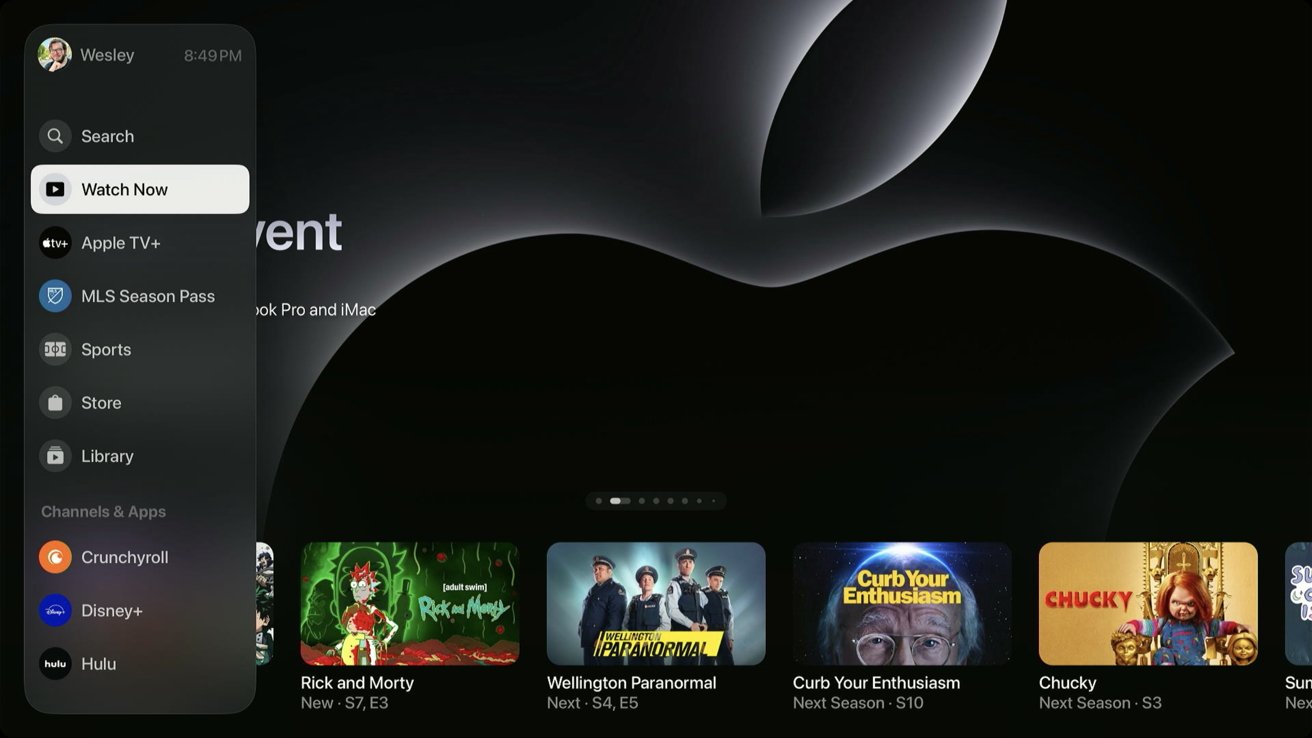
Apple TV app redesign
The Apple TV hardware runs the Apple TV app, where the Apple TV+ service lives as a Channel. Until now, the Apple TV app was a mishmash of every piece of content available with minimal sorting options.
With tvOS 17.2, users get an all-new Apple TV app design. The primary Apple TV app experience remains mostly unchanged, but the top menu and navigation are much better thought out.
First, the top tab switcher has moved to a sidebar with many more options. The sidebar emphasizes available content sorted by Channels, but Apple TV, MLS, and iTunes content get the top spots.
And no, there isn't any way to remove the MLS Season Pass or Sports Channels. Apple will let you hide unwanted channels or apps but not any of its apps or services. (Coming to an antitrust case near you)
Watch Now is still a collection of any content enabled to populate the Apple TV app. The old circle icon Channels section is now "My TV" with square icons, which also merged with the apps section.
Select a Channel or app from My TV or the sidebar to jump to a dedicated page containing content just from that service. Channels have always had dedicated Up Next queues, but now so do apps.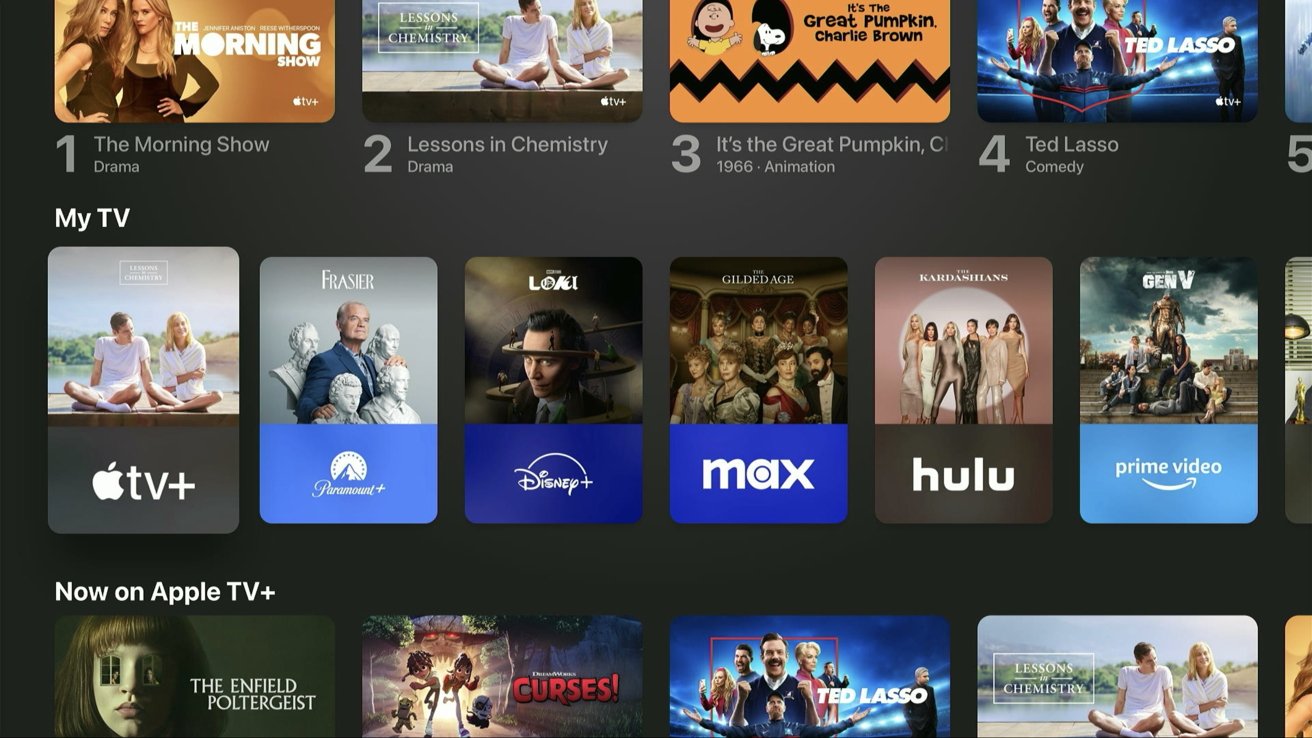
The new My TV section combines apps and Channels
There were so few premium Channels built into the Apple TV app that users likely never interacted with them outside of Paramount+. Now, apps like Disney+ and Max feel like they are part of the TV app in a way they never did before.
Netflix still isn't part of the Apple TV app or Up Next, and playing a video belonging to an app still launches the dedicated app to play it. However, the improved navigation of the sidebar and My TV sections makes everything much easier to navigate.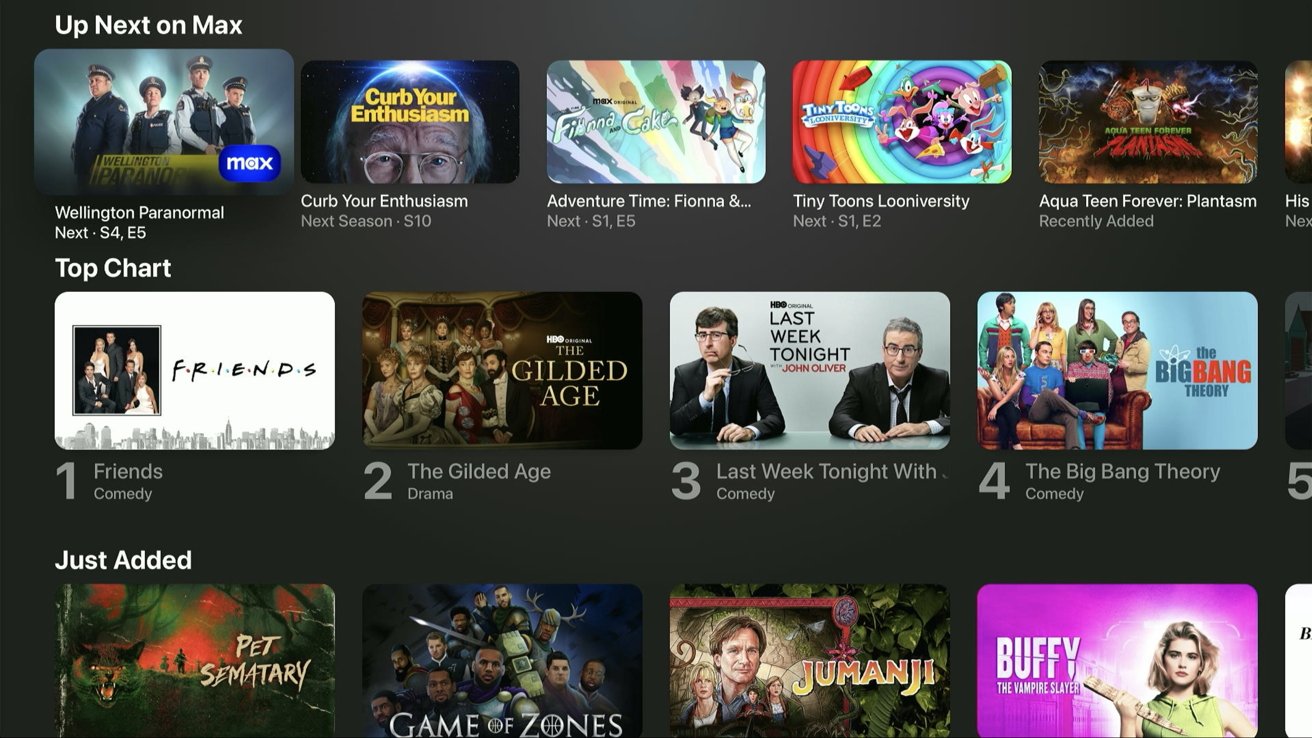
Max gets a dedicated Up Next section
As long as you're inside a dedicated Channel or app section, all the content presented is part of that service, with few exceptions. Apps like Amazon Prime will still fool you into believing a piece of content is available within the Amazon Prime app but then ask for a digital purchase.
The Library tab contains everything purchased from iTunes. The sorting between movies, TV, 4K titles, and genres is still available, but there's a new set of glyphs depicting each genre.
The Library tab gets new glyphs for the genres
The iTunes Store is still part of the Apple TV app but has combined the movie and TV sections. This streamlined experience is expected to replace the dedicated Movies and TV Shows apps on Apple TV, but they are still in tvOS 17.2.
The combined storefront still needs some work. It's mostly the movies view from before, but a few TV series options are intermixed.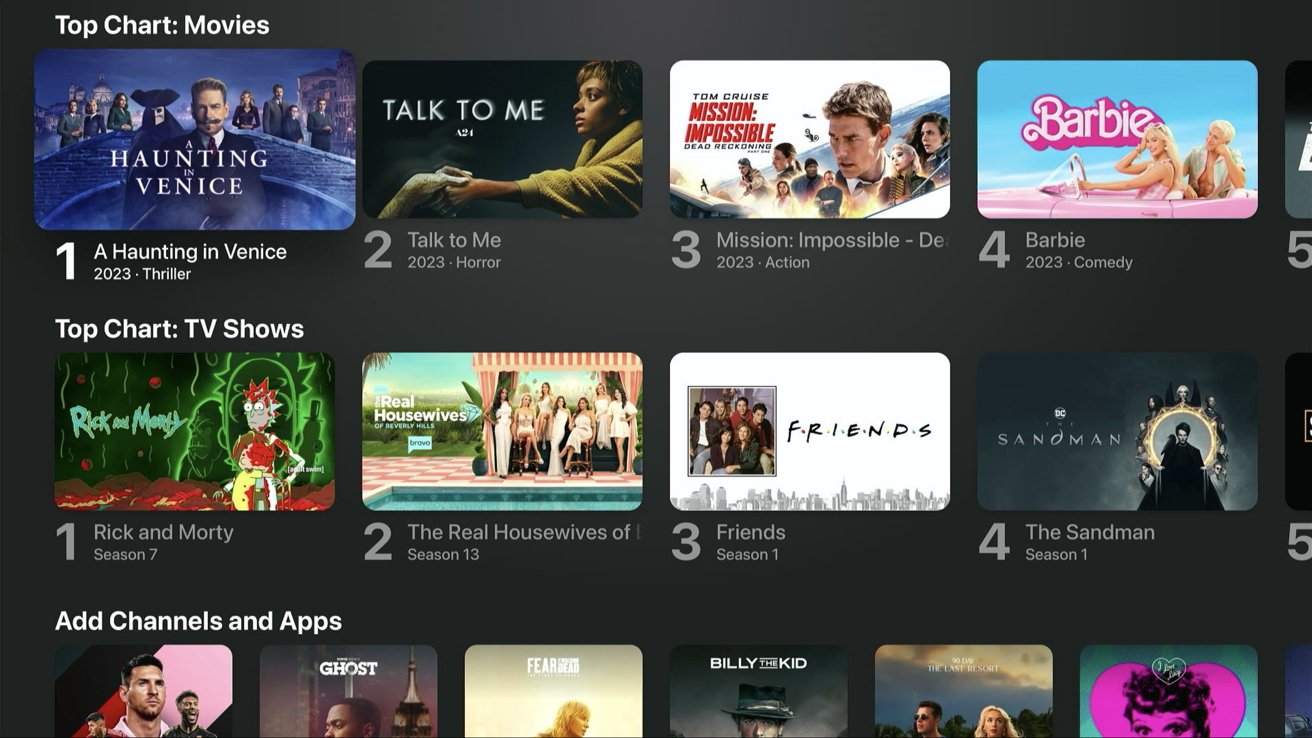
iTunes combined movies and tv shows into one section
The updated Apple TV app interface might take some getting used to, but we expect it will be a big win for ease of use. It also acts as an excellent showcase for Apple to convince more apps to join Apple TV Channels so users don't need to launch a separate app.
While the Apple TV app isn't perfect, the latest redesign is a step in the right direction. We're not sure Apple will ever convince companies like Disney to join Channels, so this is the next best thing -- treating Channels and apps like equal services within the TV app.
Read on AppleInsider

-
France's iPhone 12 modem power testing was radically different than the standard
A support document by Apple details how France's iPhone 12 radio power testing differed greatly from international standards, which will lead to the iOS 17.1 update cutting power to the model's modem.
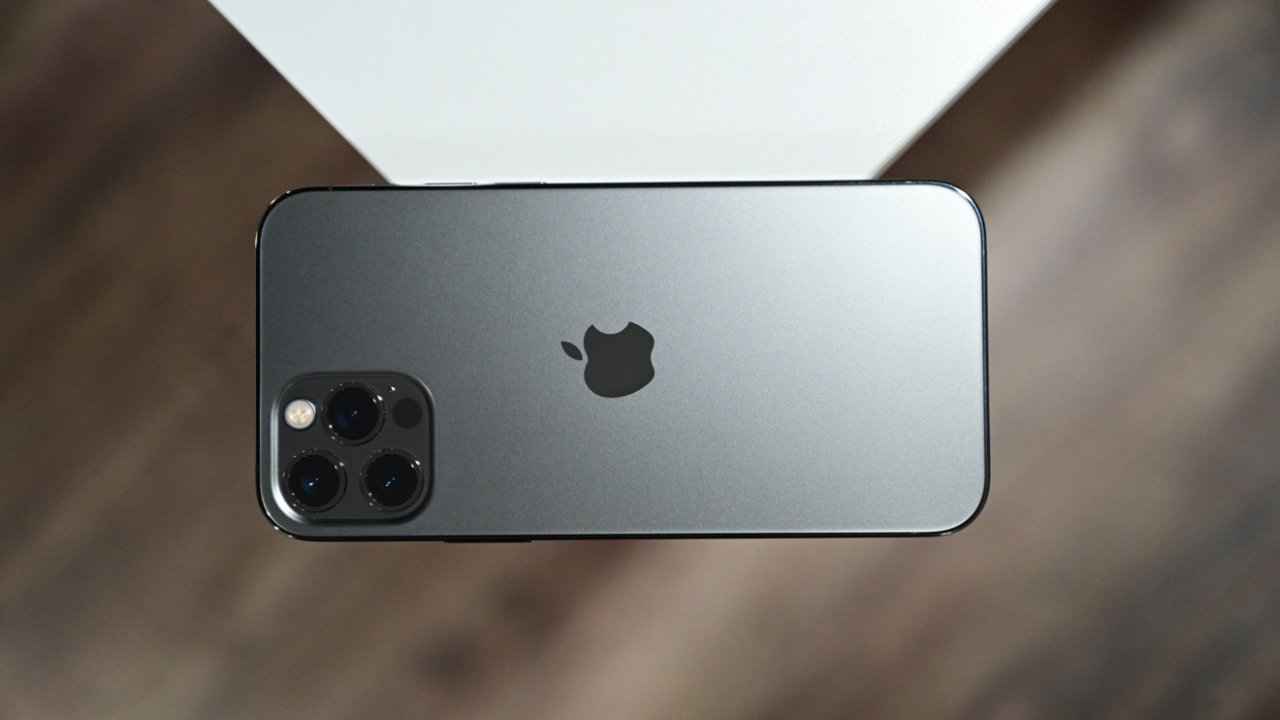
iPhone 12 on the edge of a recall
About a month after drama flared up about the iPhone 12 exceeding radio frequency legal limits, Apple has published a support documenting the iPhone 12, France's testing, and why the iPhone 12 was found non-compliant. In the document, Apple spells out that the iPhone 12 -- and every iPhone for decades -- detects when it is on a table and not adjacent to a user's head, and will dial up power to the modem to help it connect to more distant cellular towers.
"For more than a decade, iPhones have had an off-body detection feature that allows for slightly higher transmit power when you set the phone down, for example, on a table," Apple says. "This has been thoroughly tested and verified internationally to be an effective mechanism to comply with SAR requirements. The slightly higher power is not applicable to SAR compliance since the phone is on the table, not on your body."
Apple is not the only vendor that does this. Samsung and Google -- and likely every other cell phone manufacturer -- do the same thing, which complies with international regulations, standards, and testing protocols. It's unclear why France's radiation watchdog used a protocol that did not account for the "off-body detection mechanism."
"The specific test protocol used by ANFR requires that devices meet the on-body SAR limits, even when the device is tested off-body on a static surface," Apple wrote. "This decision is not consistent with international standards, which allow for independent testing of power control mechanisms that may not be activated during standard SAR tests."
The document also spells out that the power reduction in iOS 17.1 is only happening to customers in France.
"iPhone 12 will no longer increase the allowed power when the off-body state is detected, such as while it is sitting on a table," says Apple. "As such, in coverage areas where cellular signal is low, this change in antenna transmit power may result in slightly lower cellular performance in certain off-body use cases. The vast majority of users are not expected to notice any impact."Radio frequency power versus ionizing radiation
RF radiation is not the same as ionizing radiation generated by the decay of radioactive isotopes and from the sun itself -- and the mechanism of damage is different. Ionizing radiation breaks the bonds in cells, where sufficiently high levels of RF radiation can heat tissue and could theoretically cause tissue damage.
While radiation exposure is measured in gray, sieverts, or rem per hour, depending on the country, Specific Absorption Rate (SAR) is more universal. SAR is a measure of the rate at which the body absorbs RF energy. A SAR of 1 watt per kilogram would increase the temperature of an insulated slab of tissue by one degree Celsius per hour of exposure at that wattage and does not account for the loss of that temperature increase from any other factor.
Unlike the trio of ionizing radiation measurement methods, SAR is a measure of that heat and not an absolute measure of damage. Generated heat is what can theoretically cause damage from RF exposure, but the measurement -- and how it is measured and regulated -- is controversial.
Like ionizing radiation, radio frequency broadcasts decrease in power associated with a recipient's distance and shielding from the source. The further away a receiver or body is away from a source, the lower power of the exposure to the source.
So, in the case of an iPhone broadcasting at an equivalent power to France's measured 5.4 W/kg on a table away from a user, means that a body part like a hand even two inches away is getting well less than half that number, and realistically less than a quarter. All of these exposures are far less than the legal limit, which is a small fraction of the limit that's been established as possibly damage-causing.
Apple's testing conforms to an international industry standard. As Apple says, during testing, iPhone radios are set to the highest transmission possible manually, and SAR is evaluated in real-time, over time intervals as specified by applicable regulations.
Apple says that its SAR testing is evaluated in positions that simulate uses against the head, with no separation, plus when worn or carried against the torso of the body, with 5mm separation. Initially, reports claimed that the testing by France's regulatory agency differed from the rest of the world.
"It is important for all iPhone 12 users in France and around the world to know that iPhone 12 is safe to use and always has been," Apple says.
Read on AppleInsider

-
What's really going on with Apple's modem chip efforts?
A recent report suggests Apple's in over its head with it's iPhone modem efforts, but -- to borrow a phrase -- we think differently.
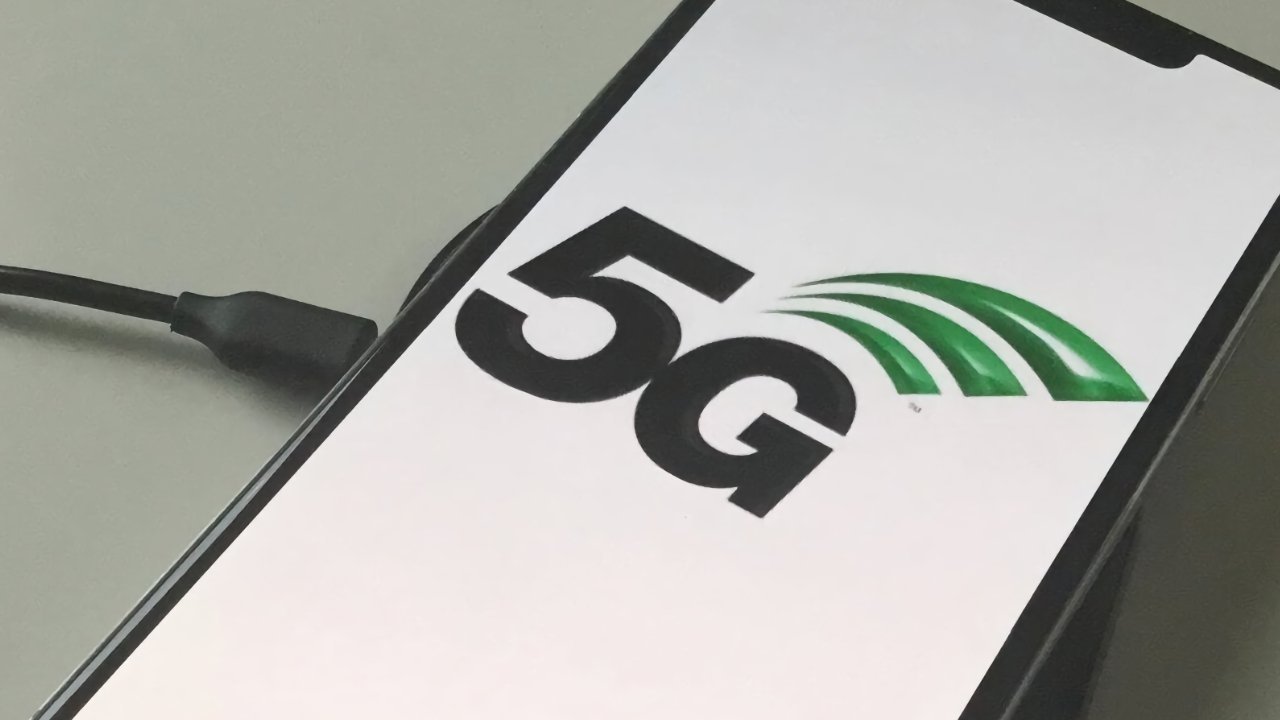
Apple is trying to make its own 5G modem for the iPhone
Apple knows what it's doing and knew what it was getting into from the start. But even the folks queried by the Wall Street Journal admit right off the bat that getting cell modems working right is no small feat.
That is among the many reasons why Apple uses Qualcomm components in its iPhones, has for years, and will continue to do so at least through 2026, as Qualcomm itself recently acknowledged.
It's no surprise that Apple has stayed mum on the subject. We expect that once it has something to talk about, it will, just as it does about A-series, M-series and other chips it makes -- look at the time it spent at the recent iPhone and Apple Watch launch crowing about the chips inside.
Apple's seemingly inevitable switch to its own modem hardware has been an open question since 2019, after Apple acquired Intel's cell modem business in a $1 billion deal that netted Apple 2,200 employees, facilities, technology, and a bevy of patents to help kickstart its modem efforts.
But this has been a long time coming. Much, much longer than that.Apple's custom silicon history
Apple's experience with custom integrated circuit design long predates the iPhone, and even the Mac, for that matter.
Apple co-founder Steve Wozniak designed a one-chip floppy disk controller solution for the Apple II called the IWM (Integrated Woz Machine). Apple's been designing its own custom silicon solutions ever since, such as the AIM alliance with IBM and Motorola which yielded the PowerPC processors used in Macs for years.
Apple was also fundamental in launching Arm, the company that owns the IP behind the processors Apple now designs for its own products. Arm -- founded in 1990 as Advanced RISC Machines Ltd. -- was a joint venture between British PC maker Acorn Computers, Apple and VLSI Technology.
Before it became the semiconductor juggernaut it is now, Arm made processors used in Apple's Newton MessagePad and other products.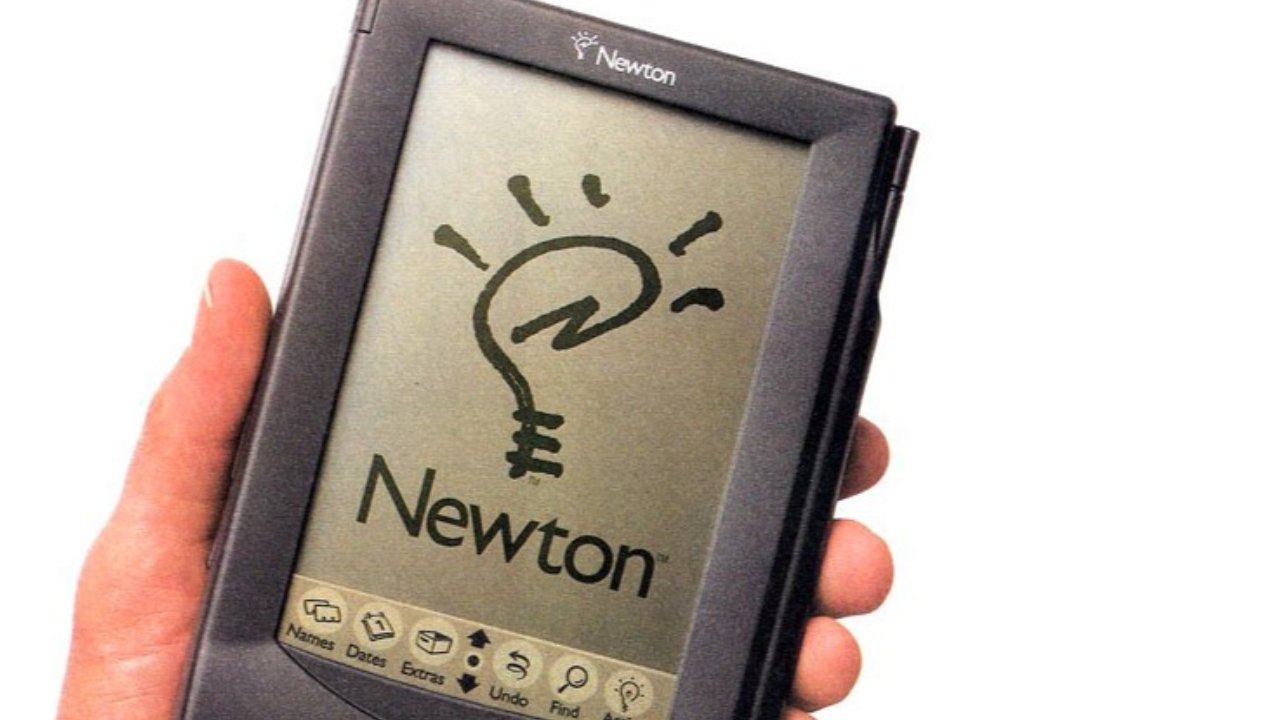
Apple's Newton MessagePad ran on an ARM-designed processor
More recently, Apple was among Arm's key strategic investors for its 2023 IPO, agreeing to a new chip technology deal that "extends beyond 2040," according to an Arm regulatory filing.
Apple bought chip design firm P.A.Semi in 2008, kicking its own chip design efforts into gear and yielding results beginning in 2010 with the introduction of the A4, the SoC inside the iPad, the iPhone 4, 4th-gen iPod Touch, and the 2nd-gen Apple TV.
By the time Apple acquired Intel's cell modem business in 2019, the company had already been developing its own mobile-focused SoC designs for more than a decade, led by the company's Senior VP of Hardware Technologies, Johny Srouji.
Contrary to the implication in the WSJ article, Apple knows what it's doing here, even though the stakes in 5G might be a bit different.
The article claims that by late 2022, Apple's modem hardware was about three years behind Qualcomm. Tantra Analyst founder and principal Prakash Sangam points out that Samsung and Huawei have run into challenges to develop hardware that can compete with Qualcomm.
"[Samsung and Huawei] are definitely not beating but not even equal to Qualcomm in terms of performance, feature set support, number of bands, and band combinations" said Sangam.
Given the amount of time Apple has purportedly been developing its modem hardware, Sangam thinks Apple is actually on track, not behind. From Sangam's perspective, Apple may have thought it could make a modem quicker than other companies but reality has caught up to it.
"That's more in line with Samsung and Huawei's timelines, so that seems realistic," he said.
"Building [a] modem is hard, which Apple is realizing, unlike its SoC effort. So, that is worth noting," Sangam added.Why Qualcomm?
Qualcomm isn't the only company that makes modem silicon for cell phones, but they're the 800 pound gorilla, because they've been center-stage in the business since there was a business.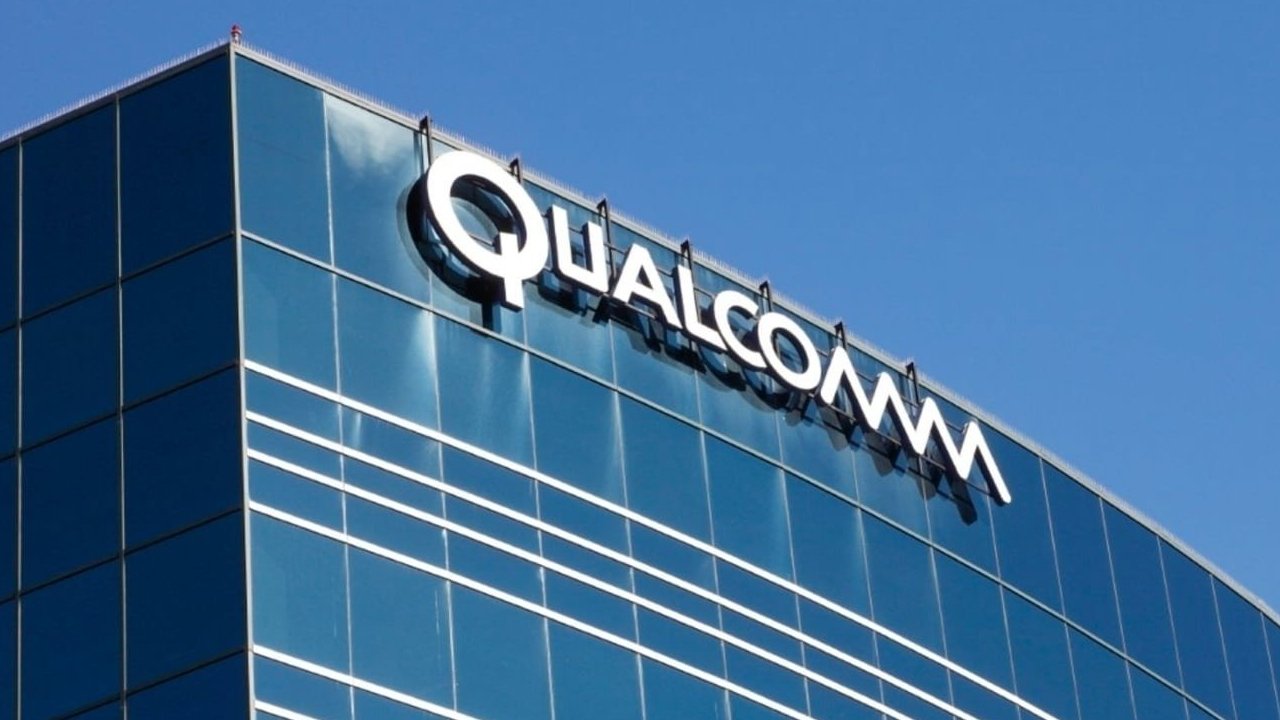
There are few smartphone manufacturers with the volume and the acumen to pay Qualcomm for licenses while still rolling their own chips, like Samsung and Huawei. It only makes sense then that Apple should be in that mix, so why isn't it?
Bottom line: if you're a smartphone maker, you're either paying Qualcomm for parts, licensing Qualcomm IP, or paying someone else to license Qualcomm's patents.
Apple found itself doing more than one of those things at a time. Which is one reason why Apple and Qualcomm have dragged each other through U.S. federal courts on and off, for years.
Qualcomm is an IP juggernaut, with more than 140,000 patents under its belt, many of which are essential to the operation of cell phones -- what's known in IP law as "standards-essential patents" or SEPs. The company's licensing business nets it billions in annual revenue.
The baseband processor is the radio network interface for a cell phone -- an essential component for it to operate. Apple didn't start out using Qualcomm-made baseband chips, but Apple's complicated history with Qualcomm goes back to those first iPhones.
For the first several years of the iPhone's development, Apple used baseband chips made by German semiconductor maker Infineon. Apple eventually negotiated a licensing deal with Qualcomm, leading to an exclusive deal between the two companies in 2011. That deal didn't work out, so the companies sued each other, eventually settling out of court in 2019.
Legal actions between the two companies have erupted ever since, though Apple's efforts to overturn Qualcomm's patents in court have been pretty consistently rebuffed by federal judges straight up to the Supreme Court, which refused to hear their case in 2022.
At this point the two companies are in an uneasy state of detente. Qualcomm chips are still in iPhones, and Qualcomm says that it will still be providing chips to Apple through 2026.
The question isn't if this will change, but when. Apple's continued reliance on Qualcomm for such a key component of the iPhone is, without question, not what the company wants to do.
Tim Cook has been telling investors since 2009 -- about a year after the P.A. Semi deal was announced -- that Apple wants to own and control the primary technologies behind its products.
One interesting footnote here: Infineon, the company that provided Apple with the baseband modem for the first iPhones, sold its wireless business segment to Intel in 2011 after Apple made its deal with Qualcomm. It's much of that business Apple would spend $1 billion for, less than a decade later.5G: a moving target
Even if Apple has more than enough expertise to design an effective baseband chip, it's still wading into very deep waters with its own cell modem. The telecom industry operates in very long cycles of technology development and deployment, and 5G is still very much a work in progress.
5G is all we hear about, both from Apple and from network operators trying to upsell us to the latest plans. And in fairness, 5G now blankets most population centers around the U.S. and China.
But we're still very much living in a 4G world, 14 years after the technology first debuted.
For some perspective on this, consider a few data points offered by telco giant Ericsson. The company's latest annual network coverage outlook noted that global 4G coverage extended by late 2022 to about 85% of the global population.
By comparison, global mid-band 5G coverage had only reached about 10% of the global population (30% inside of China). Those coverage figures actually put 5G ahead of where 4G was at the same stage of its deployment. But there is still a lot of runway, and "5G" itself is very much a work in progress.
The process of rolling out new generations of cell tech starts with the 3GPP, an organization that develops and maintains global telecom specifications. Those specs are then implemented by regional standards bodies, then later filter down to semiconductor companies and handset makers.A seat at the table
Implementing a new generation of phone technology is a bureaucratic effort that takes years, filtering through to hardware makers once the details have been worked out in endless committees. Apple, unlike Qualcomm with its thick stack of essential patents and other players, was starting from scratch with the 3GPP after the Intel acquisition.
Apple lacks representation on the chairs of 3GPP committees, and, in fact, the 3GPP implemented new rules this year precisely to prevent individual businesses from gaining too much power and influence within the groups which vote on 5G feature and service design and deployment.
The rule doesn't single out Apple. But the company's recent efforts to stack groups with members mirrors what other telecom businesses have been also been trying to do, necessitating the change.
Meanwhile, the 3GPP and the telecom industry is moving towards the release of "5G Advanced" features. Those are aimed at improving network performance to gear it up to support virtual reality, AR and MR.
There can be little question that as Apple sees this as crucial to its spatial computing efforts. The Vision Pro is only the first spatial computing device Apple has planned, and it's entirely dependent on wireless local networking.
But it's easy to imagine portable implementations of the technology which take advantage of future high-speed, low-latency cell connections to provide users with a realistic and immersive experience even when they can't get on Wi-Fi.
Those new capabilities are still in committee for another year or two, and it'll be even longer still before they're etched onto silicon. This makes it a good time for Apple to get in the mix with its own hardware.
"One thing going for them right now, at least for next one or two years, is the incremental jump in feature sets and capabilities on 5G modems," said Sangam. "It's a kind of an improvement that has slowed down."There's nothing to see here, move along
We understand well that there's no love lost between Apple and Qualcomm, after years of legal wrangling and broken and renegotiated contracts. But that doesn't mean Apple is fumbling its own solution just to get them out of the way, in fact, quite the contrary.
It's clearly in Apple's best interest to control its own destiny with its silicon rather than leaving such a crucial piece of the iPhone puzzle to an unreliable partner. That keeps in line with Tim Cook's doctrine of controlling principle technology.
And it's important to note that Apple has dramatically expanded chip engineering efforts in recent years, opening new development centers in Israel to accommodate the rush of new projects.
Ultimately, the WSJ paints a very unflattering portrait of Apple's modem efforts that simply doesn't pass the smell test for anyone with even a passing familiarity with how Apple runs, or how the telecom business operates.
The truth is more mundane: It simply takes time and many iterations to get this sort of technology right, especially for a company like Apple that only wants to project technological primacy for its flagship products.
Read on AppleInsider
-
New iPhone 15 teardown gets into microscopic detail
A brand-new teardown of the iPhone 15 uses a microscope to highlight what's tucked away beneath the shell of Apple's flagship smartphone.
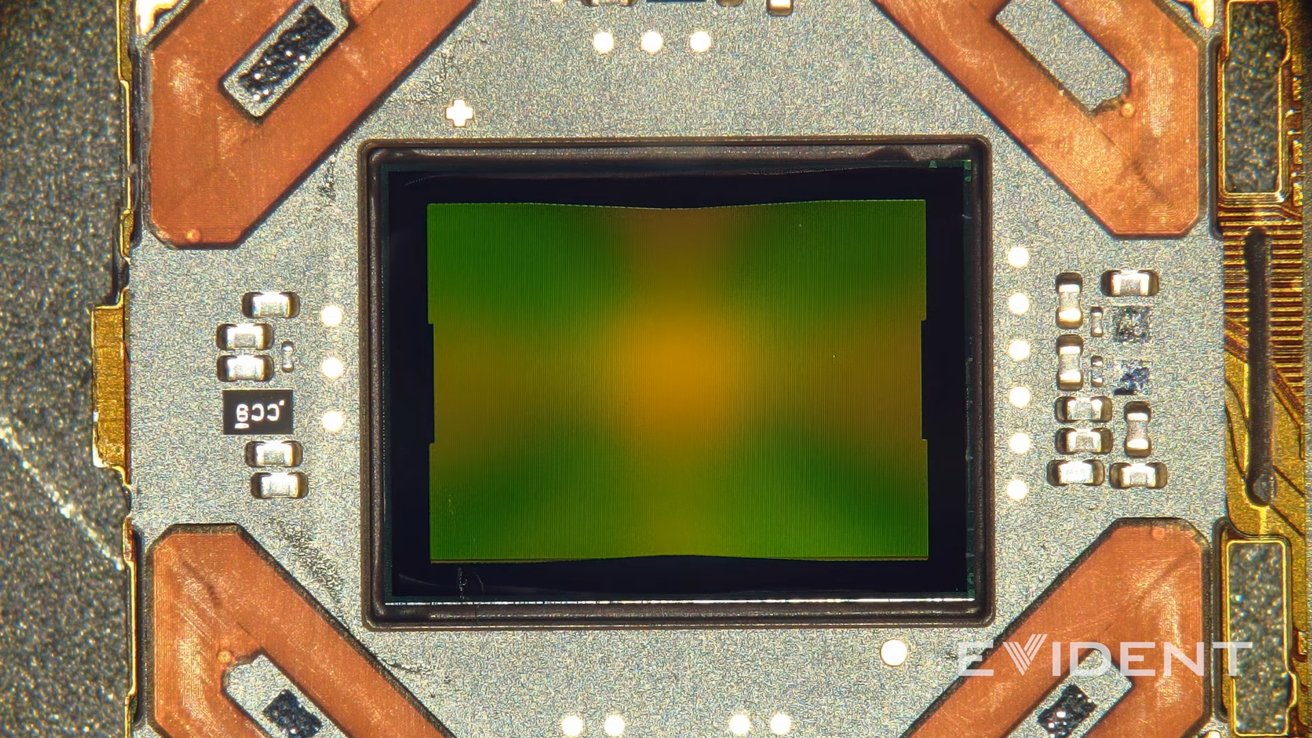
Image Credit: iFixit
Every year, iFixit does teardowns of Apple's yearly iPhone releases. This year is a little different, thanks to a partnership with Evident Scientific. The teardown now includes footage from a DSX1000 microscope, allowing viewers to get an up close and personal look at the inside of the iPhone 15.
As iFixit notes, the inside of the iPhone 15 doesn't look too dissimilar from the inside of an iPhone 14.
The video notes that the microphone on the base iPhone 15 and iPhone 15 Plus allegedly is now reparable in-store. However, that does not seem to be the case for the iPhone 15 Pro lineup.
When removing the battery, they discover it features a new message that reads "Warning: Trained Technician Serviceable only."
When it comes time to disassemble the camera module, they show off the 48-megapixel image sensor. They note that even though the iPhone 15 and iPhone 15 Pro both have a 48-megapixel camera, the quad-pixel buckets in the base iPhone 15 model are 22% smaller. This results in worse performance in low-light settings.
The logic board seems to be easier to repair this year. Often, the logic board must be accessed by removing the screen, but on the iPhone 15, the brackets that hold the board are also accessible from the back.
They wrap up the video by giving the iPhone 15 a preliminary 4 out of 10 reparability score. This is largely due to Apple's tendency to pair parts with software components, limiting which parts can be used to make repairs.
Read on AppleInsider
